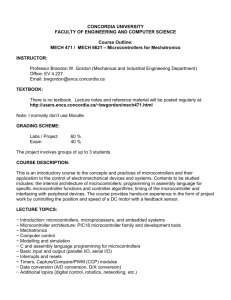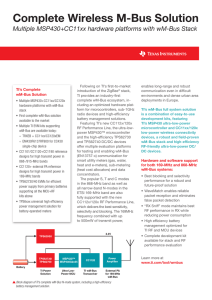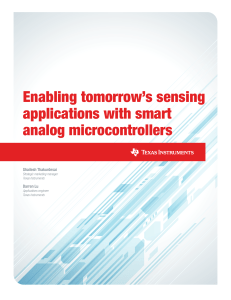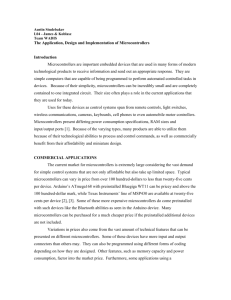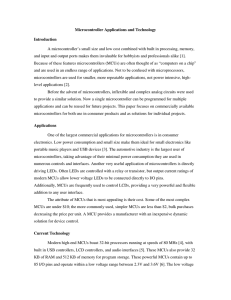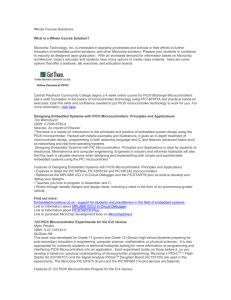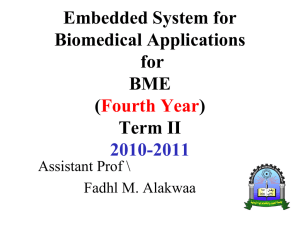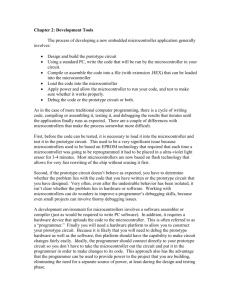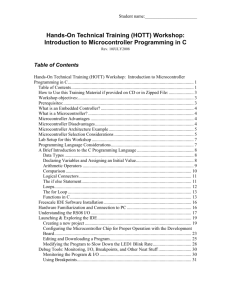DOC
advertisement
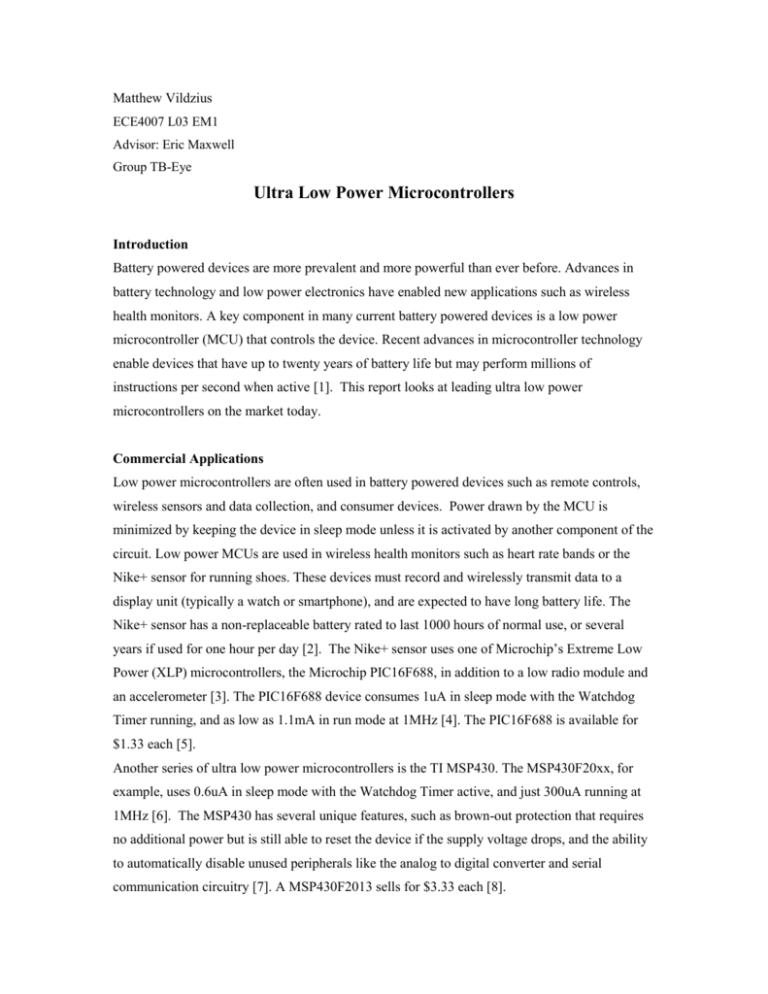
Matthew Vildzius ECE4007 L03 EM1 Advisor: Eric Maxwell Group TB-Eye Ultra Low Power Microcontrollers Introduction Battery powered devices are more prevalent and more powerful than ever before. Advances in battery technology and low power electronics have enabled new applications such as wireless health monitors. A key component in many current battery powered devices is a low power microcontroller (MCU) that controls the device. Recent advances in microcontroller technology enable devices that have up to twenty years of battery life but may perform millions of instructions per second when active [1]. This report looks at leading ultra low power microcontrollers on the market today. Commercial Applications Low power microcontrollers are often used in battery powered devices such as remote controls, wireless sensors and data collection, and consumer devices. Power drawn by the MCU is minimized by keeping the device in sleep mode unless it is activated by another component of the circuit. Low power MCUs are used in wireless health monitors such as heart rate bands or the Nike+ sensor for running shoes. These devices must record and wirelessly transmit data to a display unit (typically a watch or smartphone), and are expected to have long battery life. The Nike+ sensor has a non-replaceable battery rated to last 1000 hours of normal use, or several years if used for one hour per day [2]. The Nike+ sensor uses one of Microchip’s Extreme Low Power (XLP) microcontrollers, the Microchip PIC16F688, in addition to a low radio module and an accelerometer [3]. The PIC16F688 device consumes 1uA in sleep mode with the Watchdog Timer running, and as low as 1.1mA in run mode at 1MHz [4]. The PIC16F688 is available for $1.33 each [5]. Another series of ultra low power microcontrollers is the TI MSP430. The MSP430F20xx, for example, uses 0.6uA in sleep mode with the Watchdog Timer active, and just 300uA running at 1MHz [6]. The MSP430 has several unique features, such as brown-out protection that requires no additional power but is still able to reset the device if the supply voltage drops, and the ability to automatically disable unused peripherals like the analog to digital converter and serial communication circuitry [7]. A MSP430F2013 sells for $3.33 each [8]. Underlying Technology There are several techniques microcontroller manufacturers can use to reduce power consumption. Typically a low power MCU spends most of its time in a sleep state where most of the device is inactive. In different levels of sleep, on-chip peripherals such as timers and parts of the CPU may be shut down. To reduce power farther, the clock may be slowed down or turned off. In the lowest power state the only parts of the MCU that remain active are the RAM and a circuit to handle external interrupts to wake the device [9]. An important feature is the ability to quickly stabilize the high speed clock when the device wakes from sleep so that instructions can be executed and the device can go back to sleep mode without consuming too much energy. The TI MSP430 can stabilize an 8MHz clock in just 292ns, compared to up to 1ms for some competing devices to reach full speed [9]. Another specification to consider is low IO pin leakage. At low current scales, leakage current on the IO pins becomes an issue especially on high pin count devices. The TI MSP430 also uses a new type of random access memory (RAM) called Ferroelectric RAM, or FRAM. Unlike Dynamic RAM (DRAM), FRAM is non-volatile, so no power is required to preserve data. FRAM also has an advantage over traditional EEPROM that is commonly used for non-volatile storage in that it can withstand trillions of write cycles, not just thousands [10]. Building Blocks for Implementation of Low Power Microcontrollers An important part of a low power microcontroller device is software that minimizes power consumption by turning off unnecessary peripherals, using the microcontroller efficiently, and staying in sleep mode as much as possible. TI provides a recommended program flow as well as information to write programs that minimize power consumption. The code running on the device must be configured in a specific way to take advantage of features such as the low power watchdog timer and varying clock frequency [11]. In addition to software, the hardware connected to the microcontroller must be designed with low power in mind. It is important to keep the MCU in sleep mode as much as possible and wake it up with external interrupts from another part of the circuit when necessary. Continuously sampling a sensor, for example, would use prohibitive amounts of power so instead another solution must be found, such as triggering the microcontroller when the sensor detects a signal of interest [3]. By combining a carefully designed circuit, efficient code, and a low power microcontroller, it is possible to make a device that has years of battery life without sacrificing functionality or user experience. References [1] Microchip Technology, “nanoWatt XLP eXtreme Low Power PIC®MCUs,” Apr. 2010 [Online]. Available: http://ww1.microchip.com/downloads/en/DeviceDoc/39941d.pdf [Accessed 5 Sept. 2011]. [2] Nike, “Nike+ SportBand User’s Guide,” [Online]. Available: http://nikeplus.nike.com/nikeplus/utility/v1/en_US/help.html [Accessed 6 Sept. 2011]. [3] D. Carey, “Runners get iPod virtual trainer,” EETimes, Aug. 2006. [Online]. Available: http://www.eetimes.com/design/other/4004584/Runners-get-iPod-virtual-trainer [Accessed 6 Sept. 2011]. [4] Microchip Technology, “14-Pin Flash-Based, 8-Bit CMOS Microcontrollers with nanoWatt Technology,” PIC16F688 Datasheet, 2007. [5] Digikey, “Digi-Key - PIC16F688-E/SL-ND,” digikey.com, Sep. 2011. [Online]. Available: http://search.digikey.com/scripts/DkSearch/dksus.dll?Detail&name=PIC16F688-E/SLND [Accessed 5 Sept. 2011]. [6] Texas Instruments, “MSP430F20x3, MSP430F20x2, MSP430F20x Mixed Signal Microcontroller,” MSP430F20x3, MSP430F20x2, MSP430F20x Datasheet, Aug. 2005. [Revised Aug. 2011]. [7] Texas Instruments, “MSP430F21x1 Architecture Summary,” Application Report SLAA217, Oct. 2004. [8] Digikey, “Digi-Key - 296-19705-1-ND,” digikey.com, Sep. 2011. [Online]. Available: http://search.digikey.com/scripts/DkSearch/dksus.dll?Detail&name=296-19705-1-ND [Accessed 5 Sept. 2011]. [9] Texas Instruments, “Choosing An Ultralow-Power MCU,” Application Report SLAA207, Jun. 2004. [10] Texas Instruments, “Low-Power FRAM Microcontrollers and Their Applications,” White Paper SLAA502, Jun. 2011. [11] Texas Instruments, “MSP430 Software Coding Techniques,” Application Report SLAA294A, Mar. 2006 [Revised Aug. 2006].
